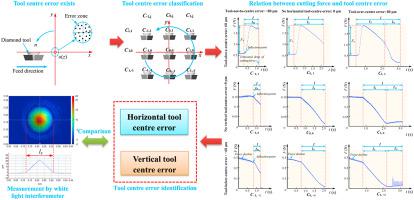Precision Engineering ( IF 3.5 ) Pub Date : 2021-02-05 , DOI: 10.1016/j.precisioneng.2021.01.019 Guoqing Zhang , Yuqi Dai , Zhihui Lai

|
In single-point diamond turning (SPDT), two-dimensional (2D) tool centre error is caused by the tool deviating from the workpiece rotation centre both in the horizontal direction (tool feed direction) and vertical direction (perpendicular to tool feed direction). This greatly affects the form accuracy of the machined surface and its optical function. Traditional tool centre error identification is usually performed off-machine manually with high-precision instruments, which is time-consuming and labour-dependent. In this paper, a novel force-based 2D tool centre error identification method in SPDT is introduced. First, according to the relative position between the tool and workpiece centre, the tool centre error is classified into nine cases. The relation between the cutting force profiles and the tool centre error is analysed for each case. Then, a numerical fitting model and a geometric model are established to identify tool-above-centre and tool-below-centre errors, respectively. Additionally, a geometric model is established to calculate the normal distance from the tool interference/exit cutting to the workpiece centre, which serves as a reference for the horizontal tool centre error identification. Finally, the on-machine identification results of the 2D tool centre error are verified by experiments. Theoretical and experimental results show that the proposed on-machine 2D tool centre error identification method is effective and accurate, which greatly improves the cutting efficiency in SPDT.
中文翻译:

单点金刚石车削中基于力的二维刀具中心误差识别新方法
在单点金刚石车削(SPDT)中,二维(2D)刀具中心误差是由于刀具在水平方向(刀具进给方向)和垂直方向(垂直于刀具进给方向)上偏离工件旋转中心而引起的。 。这极大地影响了加工表面的形状精度及其光学功能。传统的工具中心错误识别通常是使用高精度仪器在机外手动进行的,这既费时又费力。本文介绍了一种新的基于力的SPDT中基于力的二维刀具中心误差识别方法。首先,根据刀具和工件中心之间的相对位置,将刀具中心误差分为九种情况。针对每种情况分析切削力曲线和刀具中心误差之间的关系。然后,建立数值拟合模型和几何模型以分别识别工具在中心以上的误差和工具在中心以下的误差。此外,建立了一个几何模型来计算从刀具干涉/退出切削到工件中心的正常距离,该距离可用作水平刀具中心误差识别的参考。最后,通过实验验证了二维刀具中心误差的在线识别结果。理论和实验结果表明,所提出的机载二维刀具中心误差识别方法是有效,准确的,大大提高了SPDT的切削效率。建立一个几何模型以计算从刀具干涉/退出切削到工件中心的正常距离,该距离可作为水平刀具中心误差识别的参考。最后,通过实验验证了二维刀具中心误差的在线识别结果。理论和实验结果表明,所提出的机载二维刀具中心误差识别方法是有效,准确的,大大提高了SPDT的切削效率。建立一个几何模型以计算从刀具干涉/退出切削到工件中心的正常距离,该距离可作为水平刀具中心误差识别的参考。最后,通过实验验证了二维刀具中心误差的在线识别结果。理论和实验结果表明,所提出的机载二维刀具中心误差识别方法是有效,准确的,大大提高了SPDT的切削效率。











































 京公网安备 11010802027423号
京公网安备 11010802027423号